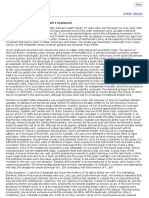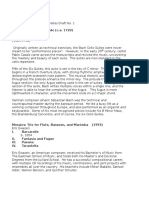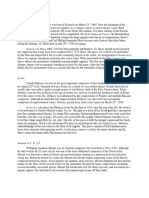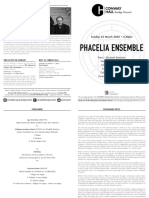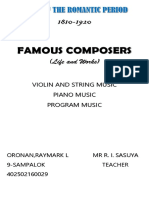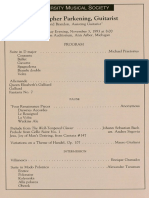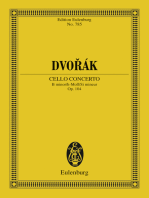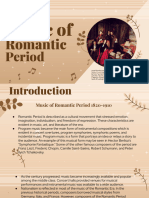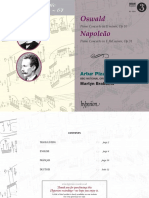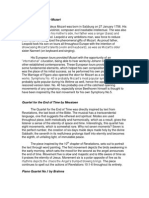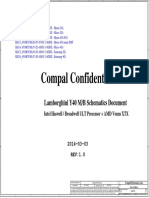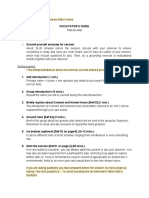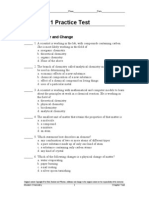Symphony Stories 1955 Nort
Uploaded by
kwancamille41Symphony Stories 1955 Nort
Uploaded by
kwancamille41SYMPHONY STORIES
bu Adeline McColl
NORTH CAROLINA SYMPHONY
THE BLUEBELLS OF SCOTLAND
AT THE NORTH CAROLINA SYMPHONY CONCERT
you will sing a song with the orchestra. Learn all three stanzas of
THE BLUE BELLS OF SCOTLAND. You will find this song in
New Music Horizons, Book 4, page 137. Here it is written in the
key of D. Did you know that if the clarinets and the trumpets in the
orchestra play this song exactly as it is written in your music book it
will sound a whole tone lower, or in the key of C? If you learn to
play the melody as it is written below, in the key of C, you will be in
tune with the orchestra. Bring your tonettes, song flutes and recorders
to the concert, and be ready to play when the director, Benjamin
Swalin, invites you to join the orchestra on the introduction to THE
BLUE BELLS OF SCOTLAND.
t ■ r J UN tf IU J
iip
t, , C F . C F &7
G' G
(? c
C C &**ii D7 G O7 Q
C F , C f G7 G7 C
^irrJuitfiijipg
1. Oh where, and oh where is your Highland laddie gone? (twice)
He's gone to fight the foe, for King George upon the thronej
And it's oh! in my heart how I wish him safe at home.
2. Oh where, and oh where does your Highland laddie dwell? (twice)
He dwelt in merry Scotland, at the sign of the Blue Bell;
And it's oh! in my heart that 1 love my laddie well.
3. Oh what, tell me what does your Highland laddie wear? (twice)
A bonnet with a feather, and on his breast a plaid.
And it's oh! in my heart that I love my Highland lad.
CHILDREN'S CONCERT PROGRAM
NORTH CAROLINA SYMPHONY ORCHESTRA
Benjamin Swalin, Director
Tenth Spring Tour-1955
OVERTURE to "The Secret of Suzanne" Wolf-Ferrari
SYMPHONY No. 8 in F Major Beethoven
Excerpts from:
First Movement—Allegro vivace e con brio
Second Movement—Allegretto scherzando
Third Movement—Tempo di minuetto
Fourth Movement—Allegro vivace
EVERYBODY SING
THE BLUE BELLS OF SCOTLAND Scotch Song
SPOT THE INSTRUMENT Scotch Song Round-Up
SUITE No. 3 in D Major J. S. Bach
Bourree
Gigue
MEMORIES OF CHILDHOOD Octavio Pinto
Run, Run!
Ring Around the Rosy
March, Little Soldier!
Sleeping Time
Hobby Horse
EVERYBODY SING
SUGAR BUSH Song of the South African Veld
MASTERSINGERS OF NUREMBERG Wagner
Dance of the Apprentices
Procession of the Mastersingers
Maxine Swalin, Commentator
EIGHTH SYMPHONY
Beethoven, 1770 - 1827
MANY YEARS AGO in the German city of Bonn, on the river
Rhine, a dirty ragged little boy named Ludwig Beethoven wandered
about on the cobblestone streets. He loved the musical sound of the
chiming tower bells and often listened to their clear, sweet tone9. When
his father noticed how much his little son liked this music, he decided
to make a musician of him.
AS TIME PASSED the child showed more and more interest in
music. Father Beethoven, who was very poor, wanted Ludwig to
earn money and help him buy food for the family. He thought it
would be a fine idea to make a "wonder-child" out of Ludwig and
send him to play concerts in all the big cities of Europe just as the
Mozart children had done. So the unhappy boy was dragged to the
keyboard and forced to practice long, hard hours. If he made a mis-
take his ears were boxed until they tingled. The neighbors often heard
him crying at the harpsichord. Many a night his father came home
from some tavern, bringing a worthless musician by the name of
Pfeiffer. Long after midnight he would pull little Ludwig out of his
warm bed and start a music lesson which lasted until morning.
LUDWIG'S MOTHER was much kinder to him than his father,
and he loved her dearly. But she was always sad and tired, busy with
housework and with his two younger brothers. Ludwig, who wa9
supposed to go to school, often missed weeks at a time. His father did
not think it was worth while to spend more than two or three months a
year with books, so Ludwig was urged on with his music study. He
took lessons on the violin, viola and organ all at the same time.
WHEN HE WAS EIGHT YEARS OLD Ludwig could play
the violin well. By the time he was eleven he was playing Bach's
"Well-Tempered Clavichord" which was considered a great accom-
plishment for a boy of that age. He could also improvise and make
up pieces at the harpsichord. Most of them were far too difficult for his
fingers to play but he said: "Never mind! Some day I will play them!"
And he did. At the age of fourteen Ludwig became assistant organist
to the new Elector. He also played second viola in the orchestras of
the theatre and the church.
TWO YEARS LATER Ludwig moved to the big city of Vienna
where an interesting thing happened. The great composer, Mozart,
was living in Vienna, and Ludwig went to play for him. The older
musician saw a shaggy-headed, badly dressed boy of sixteen go to the
piano. Not believing that this poor young fellow could play, he
EIGHTH SYMPHONY
Opus 93, in F Major
tested him by giving him a theme to improvise on. The theme was
hidden inside another tune just to make it more difficult. Of course
Ludwig picked out the hidden melody at once and improvised so
beautifully that Mozart said in surprise: "Some day the world will
hear from him!" This prophecy came true. Beethoven's music is
played and loved throughout the world to-day.
AS BEETHOVEN GREW OLDER he became deaf, but he went
right on composing. He seemed to be able to hear the melodies in-
side his head. Beethoven wrote nine great symphonies and had a
tenth one started in his sketch book when he died in 1827.
THE EIGHTH SYMPHONY, first performed in Vienna on
February 27, 1814, has become one of the favorite Beethoven sym-
phonies. It has four movements, all gay and joyous in spirit. Some
of the original themes were found in a sketch book of 1809. (Bee-
thoven had a habit of writing melodies in notebooks to use later as
themes.) If you examine the score you will find Beethoven's or-
chestra included the following instruments: 2 flutes, 2 oboes, 2 clari-
nets, 2 bassoons, 2 horns, 2 trumpets, 2 tympani, first and second vio-
lins, violas and double bass. These instruments were used in the first
performance of the Eighth Symphony which Beethoven himself con-
ducted.
FIRST MOVEMENT (2 min.)
SECOND MOVEMENT (2:30 min.)
THIRD MOVEMENT (2:30 min.)
u'Llu
FOURTH MOVEMENT (2:50 min.)
flJ J fl ] l l
^i " l jJ JI^I L UlijlU U"u
A book you will enjoy: LUDWIG BEETHOVEN AND THE
CHIMING TOWER—By Opal Wheeler (Dutton)
BOURREE AND GIGUE from Suite 3 in D Major
Bach, 1685-1750
JOHANN SEBASTIAN BACH, one of the world's greatest com-
posers, was born into a large family of musicians. Everywhere in
Germany the Bachs were famous for their music and they often gath-
ered together at family reunions to sing and play. Since they were
all deeply religious the singing usually began with hymns and a
prayer but often ended with a gay medley of tunes.
THE MEETING PLACE for these musical celebrations was
frequently Eisenach, the birthplace of Johann Sebastian. Little Se-
bastian's father held the position of Town Musician. He gave his son
lessons on the violin and viola. Not content with merely learning to
play stringed instruments, Sebastian went to the great St. Georgen-
kirche, where his cousin was organist and choirmaster. Here he spent
many happy hours listening to the organ and singing in the boys' choir.
THE DAYS IN EISENACH came to an end when Sebastian's
mother and father died. At the time the boy was scarcely ten years
old and he had to be sent to Ohrdruf to live with his older brother,
Christoph, who was a fine clavier player and taught his younger
brother to play. Hidden in the bookshelf was a fine collection of
clavier pieces by German masters which Christoph refused to let him
have. Sebastian, determined to see the precious volume, stole it out
of the library and copied it on moonlight nights. It ruined his eye-
sight, but he learned every one of the pieces. When Sebastian
grew up he became a great organist and choir director.
THE "SUITE IN D MAJOR" is one of four suites for small
orchestra, written when Bach was Kapellmeister to Prince Leopold.
THE BOURREE and GIGUE are the last two numbers in the
Suite, which includes, in addition, an Overture, Air and two Gavottes.
The BOURREE is a quick dance in 4-4 meter, played in double
time or slla breve. On every third beat there is a lively stamp.
GIGUE is the French word for Jig. It is a very lively dance,
written in 6-8 or 12-8 rhythm, used to end the suite.
/iljegro viwu&e.
A book you mil enjoy: SEBASTIAN BACH by Wheeler and
Deucher (Dutton)
MEMORIES OF CHILDHOOD
Octavio Pinto, 1890-1950
OCTAVIO PINTO, Brazilian composer and architect, enjoyed
writing pieces for children. He and his wife, the famous pianist,
Guiomar Novaes, lived for many years in a lovely big country house
outside of Sao Paulo, not far from the beautiful city of Rio de Janeiro.
As you may imagine, they had many visitors. In 1940 when Leopold
Stokowski took his Youth Orchestra to South America they were in-
vited to the Pintos' home. The children, speaking beautiful French,
helped to entertain the young American players.
PINTO'S COMPOSITIONS FOR PIANO include a Negro
Dance, Tom Thumb's March and Children's Festival MEMORIES
OF CHILDHOOD, which you will hear as an orchestra arrange-
ment, is from a set of five piano pieces. The book is dedicated to
Anna Maria and Luiz Octavio. Each piece has a little poem which
tells what is happening in the music.
I. RUN, RUN! The garden i. full of life.
In the sunshine children run about
Gaily and noisily.
Outside, on the itreet,
The poor blind man with his hand-organ
saac 11 i i'B Sings his sorrows.
II. RING AROUND THE ROSY!
"Let's play ring-around-the-rosie,'
Says little Anna Maria.
Quickly they form a ring
Singing and dancing.
III. MARCH, LITTLE SOLDIER!
3m At the other corner,
Little Luiz Octavio comes marching by
With his men, in paper hats,
>V /r Carrying wooden guns.
IV. SLEEPING TIME
The sun falls down the west,
*W
^T
*s»
*->, jr
5
r?
Six times sings the cuckoo in the clock.
The little girls sing lullabies,
Sing that their dollies must go to sJeep
Before the bogey-man comes!
V. HOBBY HORSE
And now play-time is over,
1&r
/>/> imp c>
And the children
Come prancing happily home
On their wooden hobby-horte*.
THE MASTERSINGERS of NUREMBERG
Richard Wagner, 1813-1883
THE MASTERSINGERS OF NUREMBERG is considered by
some critics to be the greatest opera written by the famous composer,
Richard Wagner. If not the greatest it is the most unusual because
it is the only one that tells a story about real people. In his other
operas Wagner relates the adventures of gods and goddesses, knights
of the Holy Grail, dwarfs and dragons who live in mysterious rainbow
worlds of the sky or under the earth. The characters in THE
MASTERSINGERS are cobblers, bakers, metal workers, builders
and their apprentices, citizens of the old German city of Nuremberg.
IN THE MIDDLE OF THE SIXTEENTH CENTURY
these people worked together in various "guilds." Those who were
interested in music formed a society or musical guild known as the
Mastersingers. In order to belong to the society it was necessary to
make up a song and sing it in an open contest.
ONE OF NUREMBERG'S RICHEST CITIZENS was Veit
Pogner, the goldsmith, a member of the singing guild. Just before
a big contest on St. John's Day the goldsmith startled his fellow
mastersingers by announcing that he would give as a prize to the win-
ning singer his greatest treasure. What could it be? Not silver or
gold, as you might think, but the hand of his beautiful daughter,
Eva, in marriage. Walter von Stolzing, a handsome nobleman who
was in love with her determined to win the prize. Walter composed
a very beautiful song but on the first trial he was turned down. How-
ever, with the help of a kindly old cobbler, Walter sang his "prize
song" in the final contest and won Eva as his bride.
THE DANCE OF THE APPRENTICES describes the clumsy
young apprentices dancing on the day of the contest.
THE PROCESSION OF THE MEISTERSINGERS describes
their stately march as they take their places on the platform.
m*f
Books you will enjoy: WAGNER by Alexander Hunt (Hyperion
Press, 1946). THE PRIZE SONG by Henriette Weber (Oxford
University Press, 1935) Stories of the Wagner operas.
SCOTCH SONG ROUND-UP
NORTH CAROLINA is proud to have a great many Scotch
people in the State. You may have heard of the beautiful lady, Flora
MacDonald, for whom the College at Red Springs was named. She
came to this country, with numerous Scotch Highland relatives, about
two hundred years ago. The Highlanders, as they were called, left
Scotland because they were tired of fighting wars. They had lost a
bloody battle trying to put their own Prince Charles on the throne of
England. "Bonnie Prince Charlie" was a friend of Flora MacDonald,
and she helped him to escape to France. The other Highlanders who
were lucky enough not to have been killed or put in prison sailed
across the ocean looking for a new home. Among them were nobles
from the richest Highland clans, and they brought—along with their
silver and gold—a patriotic spirit and a love of peace. They settled
along the Cape Fear Valley and built their homes and churches.
Descendants of these first settlers are living in this part of North Caro-
lina to-day.
SCOTCH SONGS from the old world, with the stirring music of
the bagpipe, are a part of North Carolina's heritage. As a tribute to
the Scotch tradition in the State, the North Carolina Symphony is fea-
turing a ROUND-UP OF SCOTCH SONGS. The melodies of the
songs listed below will be played by different instruments in the or-
chestra, and you will be asked to guess 1) the title of the song and 2)
the name of the instrument playing it. Listen to the instruments of
the orchestra on records so that you will be able to SPOT THE IN-
STRUMENT.
SCOTCH SONGS
NEW MUSIC HORIZONS—Book 6
p. 16 A Highland Lad My Love Was Born
p. 63 Bonnie Doon p. 183 Charlie Is My Darling
p. 110 For A' That and A' That
NEW MUSIC HORIZONS—Book 5
p. 40 Dundee p. 108 Afton Water
NEW MUSIC HORIZONS—Book 4
p. 54 Old Lochaber Lullaby
p. 137 The Blue Bells of Scotland
AMERICAN SINGER—Book 6
p. 84 Loch Lomond
MUSIC HOUR—Book 5
p. 6 My Heart's in the Highlands
p. 15 Kelvin Grove p. 37 Weel May the Keel Row
p. 17 Robin Adair p. 76 John Highlandman
p. 32 Auld Lang Syne p. 99 Annie Laurie
You might also like
- Album Of Scandinavian Piano Music - Forty One Pieces In Two VolumesFrom EverandAlbum Of Scandinavian Piano Music - Forty One Pieces In Two VolumesNo ratings yet
- Broadford Salon Concerts Programme With Lesley LewisNo ratings yetBroadford Salon Concerts Programme With Lesley Lewis2 pages
- 2ND-QRT-MUSIC 10-Wolfgang Amadeus MozartNo ratings yet2ND-QRT-MUSIC 10-Wolfgang Amadeus Mozart40 pages
- Stravinsky The Rite of Spring (Elective Music Students) PDFNo ratings yetStravinsky The Rite of Spring (Elective Music Students) PDF21 pages
- 04 - 05 - 2024 Randall Goosby CANDLER - FinalNo ratings yet04 - 05 - 2024 Randall Goosby CANDLER - Final16 pages
- Simon Crawford-Phillips and Philip Moore: Also AvailableNo ratings yetSimon Crawford-Phillips and Philip Moore: Also Available8 pages
- Play That Tune - 29 Best Tunes Made Easy to Sing and Play - Book 2From EverandPlay That Tune - 29 Best Tunes Made Easy to Sing and Play - Book 2No ratings yet
- Mnozil Brass: Happy Birthday 20 Years of A Jubilee ProgrammeNo ratings yetMnozil Brass: Happy Birthday 20 Years of A Jubilee Programme5 pages
- Suite Del Recuerdo - Jose Luis Merlin (1952-)No ratings yetSuite Del Recuerdo - Jose Luis Merlin (1952-)2 pages
- W.J. Lauffensteiner - Liner Notes - OCR PDF100% (2)W.J. Lauffensteiner - Liner Notes - OCR PDF5 pages
- Baroque Music Is A Period or Style of Western Classical Music From Approximately 1600 To 1750 Originated in Western EuropeNo ratings yetBaroque Music Is A Period or Style of Western Classical Music From Approximately 1600 To 1750 Originated in Western Europe3 pages
- PARTITURA - Peças Clássicas Fáceis para Trompete e Piano - Peter BillamNo ratings yetPARTITURA - Peças Clássicas Fáceis para Trompete e Piano - Peter Billam29 pages
- 10 Best Classical Piano Music Ever Composed - CMUSE0% (1)10 Best Classical Piano Music Ever Composed - CMUSE6 pages
- A First Book of Chopin: for the Beginning Pianist with Downloadable MP3sFrom EverandA First Book of Chopin: for the Beginning Pianist with Downloadable MP3s3.5/5 (4)
- Magic Mushrooms Change Brain Connections - Business InsiderNo ratings yetMagic Mushrooms Change Brain Connections - Business Insider4 pages
- Engineering Economics - Law of Demand - Prof. Yashvantsinh YadavNo ratings yetEngineering Economics - Law of Demand - Prof. Yashvantsinh Yadav14 pages
- Per Meter Cost Analysis (From Jani) - CanalNo ratings yetPer Meter Cost Analysis (From Jani) - Canal3 pages
- Wireless Energy Meter Reading Using RF Technology100% (1)Wireless Energy Meter Reading Using RF Technology26 pages
- Project Camelot Aaron McCollum TranscriptNo ratings yetProject Camelot Aaron McCollum Transcript31 pages
- Every Letter I Write Is Not A Love Letter': Ina BlomNo ratings yetEvery Letter I Write Is Not A Love Letter': Ina Blom10 pages
- C1 - Writing help - Informal letters (1)No ratings yetC1 - Writing help - Informal letters (1)20 pages
- Album Of Scandinavian Piano Music - Forty One Pieces In Two VolumesFrom EverandAlbum Of Scandinavian Piano Music - Forty One Pieces In Two Volumes
- Broadford Salon Concerts Programme With Lesley LewisBroadford Salon Concerts Programme With Lesley Lewis
- Stravinsky The Rite of Spring (Elective Music Students) PDFStravinsky The Rite of Spring (Elective Music Students) PDF
- Simon Crawford-Phillips and Philip Moore: Also AvailableSimon Crawford-Phillips and Philip Moore: Also Available
- Play That Tune - 29 Best Tunes Made Easy to Sing and Play - Book 2From EverandPlay That Tune - 29 Best Tunes Made Easy to Sing and Play - Book 2
- Mnozil Brass: Happy Birthday 20 Years of A Jubilee ProgrammeMnozil Brass: Happy Birthday 20 Years of A Jubilee Programme
- Baroque Music Is A Period or Style of Western Classical Music From Approximately 1600 To 1750 Originated in Western EuropeBaroque Music Is A Period or Style of Western Classical Music From Approximately 1600 To 1750 Originated in Western Europe
- PARTITURA - Peças Clássicas Fáceis para Trompete e Piano - Peter BillamPARTITURA - Peças Clássicas Fáceis para Trompete e Piano - Peter Billam
- 10 Best Classical Piano Music Ever Composed - CMUSE10 Best Classical Piano Music Ever Composed - CMUSE
- A First Book of Chopin: for the Beginning Pianist with Downloadable MP3sFrom EverandA First Book of Chopin: for the Beginning Pianist with Downloadable MP3s
- Magic Mushrooms Change Brain Connections - Business InsiderMagic Mushrooms Change Brain Connections - Business Insider
- Engineering Economics - Law of Demand - Prof. Yashvantsinh YadavEngineering Economics - Law of Demand - Prof. Yashvantsinh Yadav
- Every Letter I Write Is Not A Love Letter': Ina BlomEvery Letter I Write Is Not A Love Letter': Ina Blom



